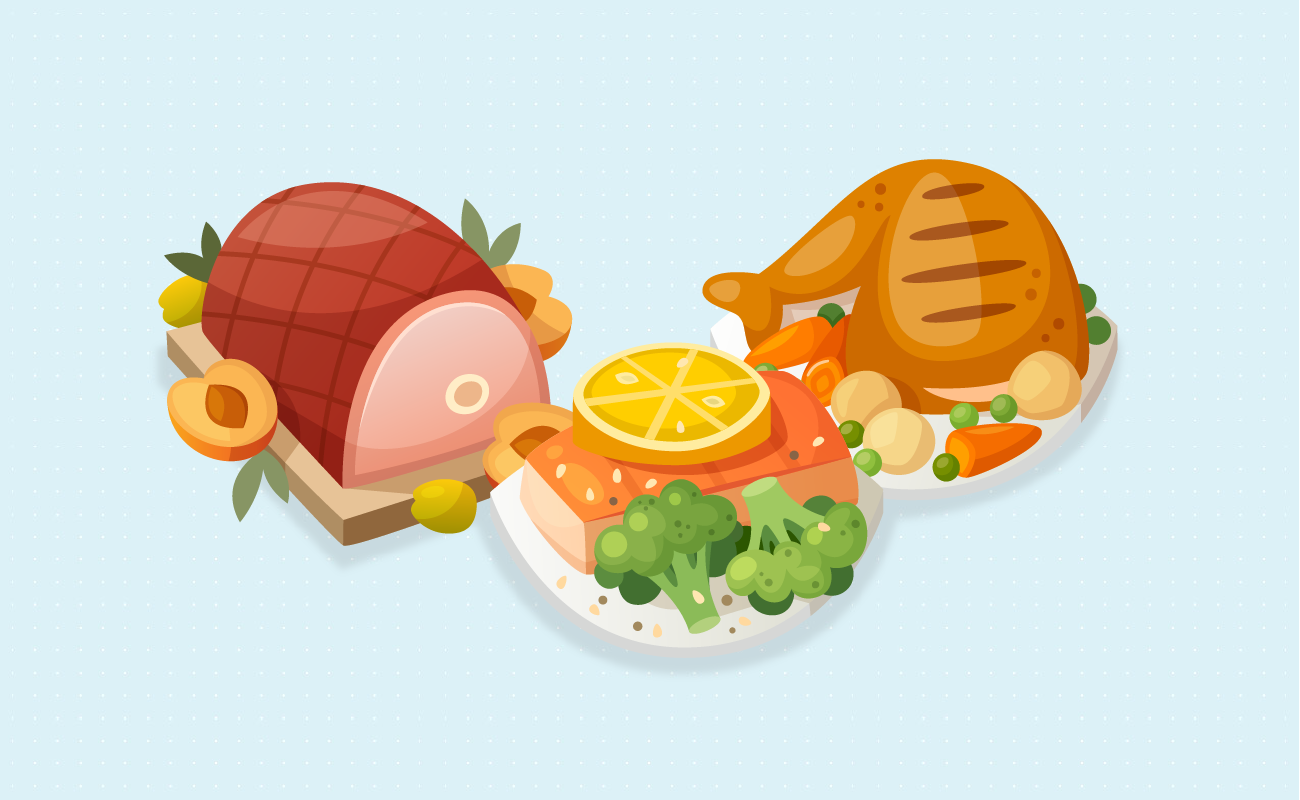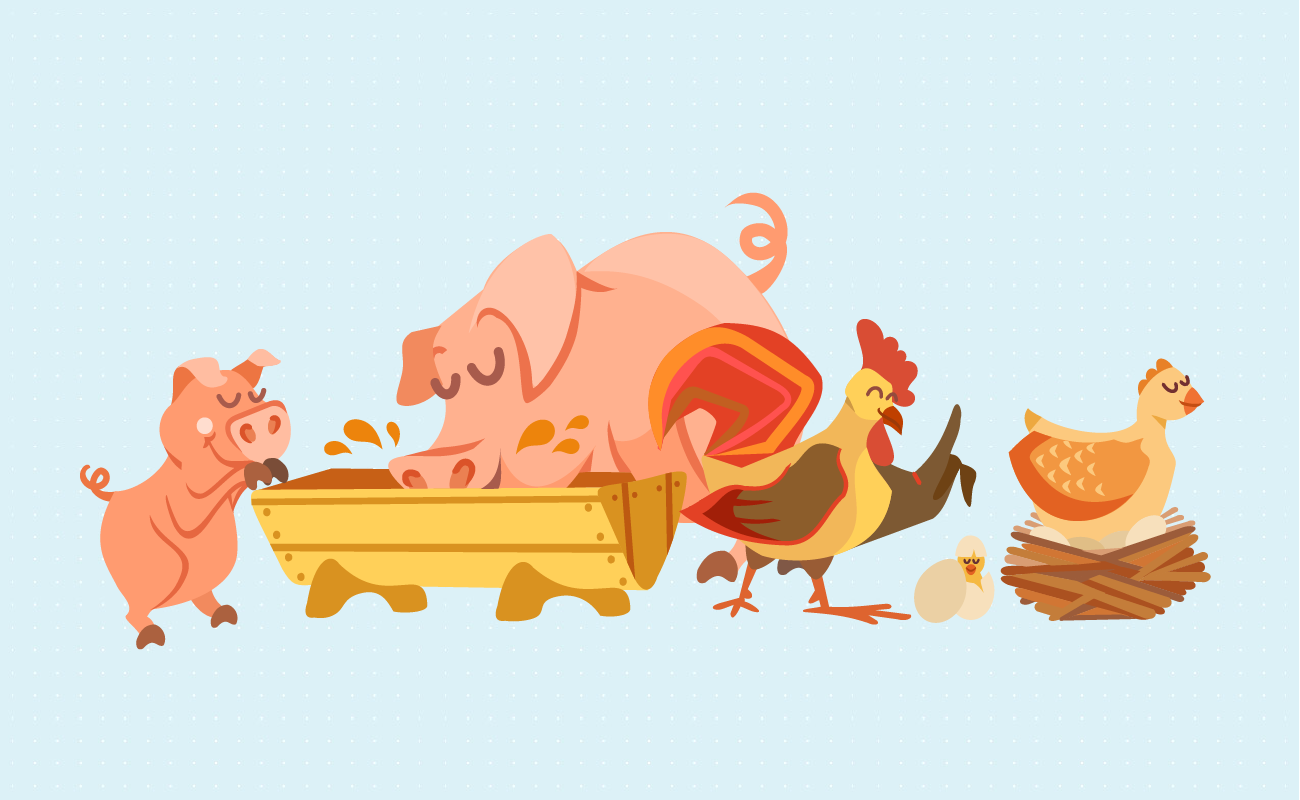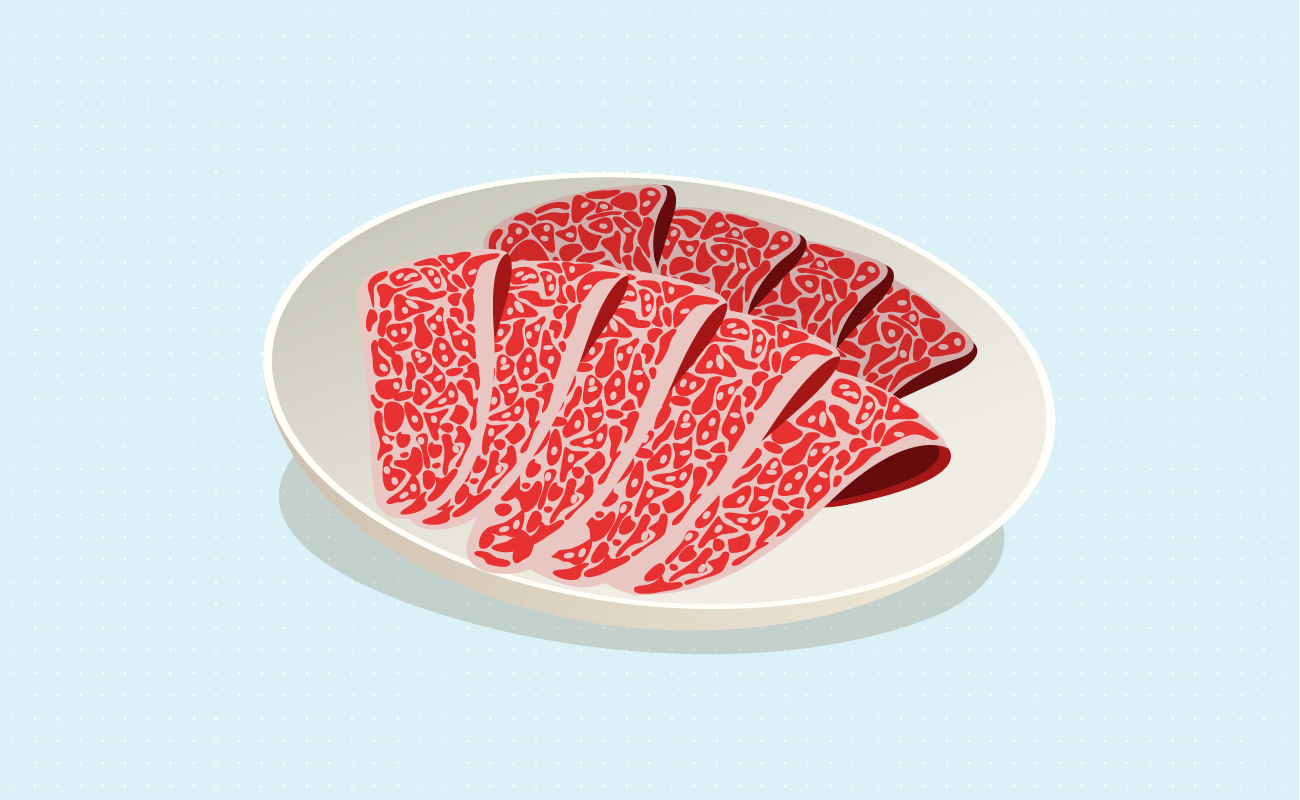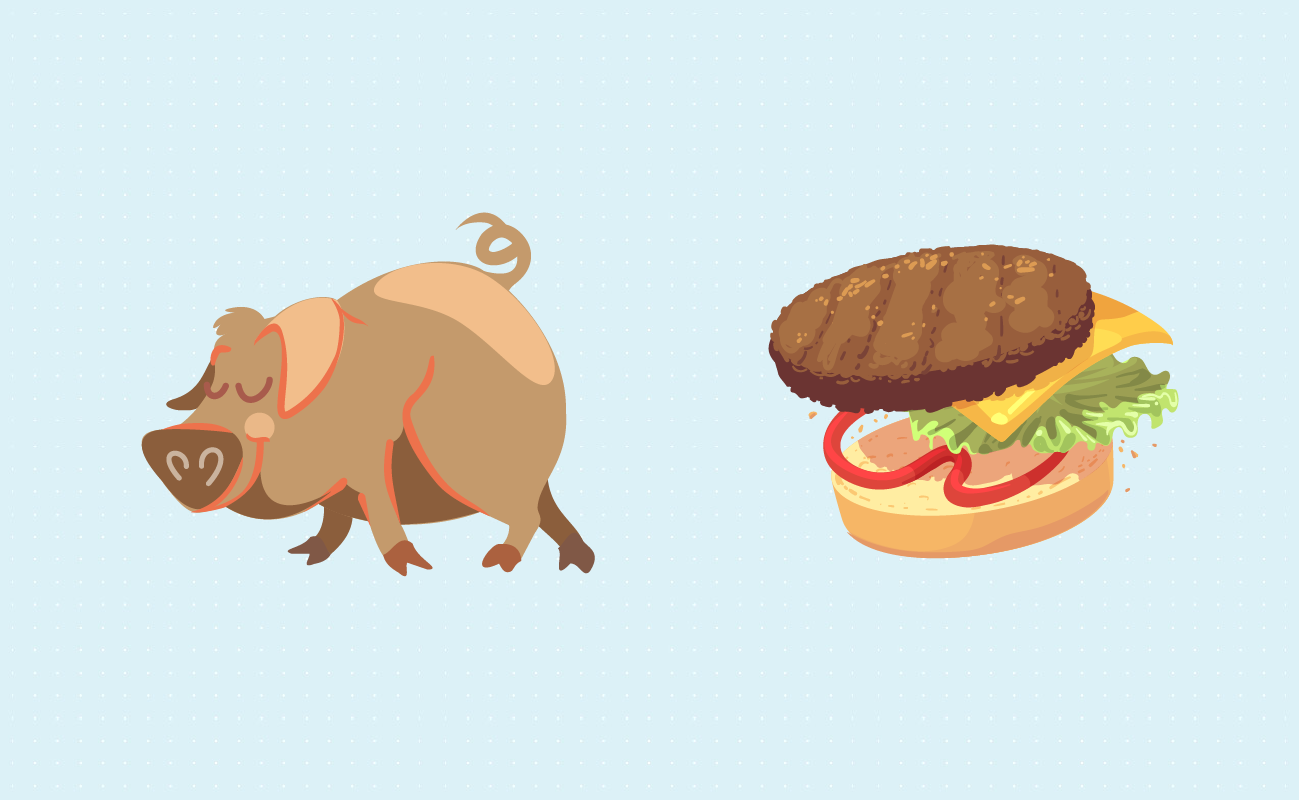 Meat Cost Per Serving Calculator
Meat Cost Per Serving CalculatorThis calculator uses the University of Nebraska-Lincoln Cooperative Extension Buying Meat by the Serving guide to help families estimate the cost of serving up to fiver different meat cuts & figure out how much meat they will need to purchase based on serving counts.
Guide published by Jose Abuyuan on February 4, 2020

For most Americans, meat is the centerpiece of a dish. The hearty dinner conjures an image of baked ham, a delightful pot roast, or a heavenly brisket. Even diners on a budget are happy with a burger from a fast food joint or a plate of bacon and eggs at a diner.
But meat can be expensive—and we're not only talking about fancy stuff like wagyu or angus. Other economic pressures play into driving up the price of everyday meat products. Thus, it becomes important for the average consumer to make the most of the meat they can afford.
Most meat in America comes from a triad of animals—pig, chicken, and cattle. Other animals (sheep, goats, deer, duck, and alligators) are also farmed on a commercial scale. The costs of commercial livestock production are steep. Animals demand more space and attention than crops, and that is only the tip of the iceberg.

It takes a lot of time and energy to produce meat. An herbivorous animal spends most of its time eating. The animal also converts more of its food into energy. Only a fraction of the feed an animal eats ever turns into animal flesh. Eating the flesh of animals, therefore, is energy intensive. For this reason, predatory animals are often outnumbered by prey animals in the wild.
Meat farming on a commercial scale needs a massive production chain to feed the animals. As if the ranches and feedlots weren't big enough, the pastures and fields for animal feed are more so.
Meat production is also dependent on the following resources:
Anything that alters these resources will affect the productivity of ranches. In recent years, ranchers have faced increasing pressure from environmental changes. Droughts in beef-producing areas have cut into the production of cattle. This, coupled with rising demand, has caused the price of beef to escalate.
There's no denying that meat production isn't the friendliest form of land use to the environment. Animals take up a lot more space and resources to produce the same amount of food as a farm. However, switching gears to an entirely plant-based diet has its own problems.
While animals may consume more land to produce, they can also use the type of land that cannot be farmed. It is thus better for the environment to have some animal production. This eliminates the need to clear more land for farming.
Game meats have their own positive impact on the environment. In the U.S., hunters serve an important role in the management of wild areas. Hunting seasons keep the numbers of deer in check in the absence of natural predators. Eager hunters also help control the numbers of nuisance invasive species like razorback pigs, which have which have no legal game status. Feral hogs can be hunted all-year-round on private land.
The overhead costs of production aren't the only factor affecting the price of meat. Some of these are related to quality. After all, demand puts pressure on some parts more than others. Some are grounded in presentation and seasonality. Buyers are often faced with the prospect of higher prices in the meat market. To save on meat, you would need to make a few choices and rethink your cooking approach.

Specific cuts often sell for more because they represent the most tender parts of the animal. Premium beef cuts, for instance, derive from the parts of the animal that were least used. Other cuts are more exercised and have denser muscle fibers. These cuts are more difficult to eat without special cooking techniques.
Cheaper cuts are also less likely to have marbling. This refers to the distribution of fat between and within muscle groups. Fat is well distributed within muscle groups in premium meats like angus and wagyu beef. This fat contributes to the tenderness and flavor of the meat.
Finally, labor costs add to the price of meat on the consumer's end. Pre-packaged, pre-cut meats all add to the cost of your grocery bill.
Any usable meat still on the animal after slaughter is recovered from the carcass. This is usually turned into processed meat products. Industrialization paved the way for greater efficiency at the cost of quality. Scraps of pork are turned into sliced ham and hot dogs. Mechanically separated chicken is turned into chicken nuggets.
Today, mass-market bacon, ham, and hot dogs often lack the quality of their traditional counterparts. These are laced with preservatives and fillers in excessive amounts, which has become a problem. The World Health Organization considers processed meat as one of the leading causes of colorectal cancer.
Game meats aren't something a city person has eyes on. These meats often have different connotations in many countries. In the U.S., exotic meats are reserved for adventurous palates while venison is a rural specialty. In the Britain, venison and game is an upmarket specialty for the posh. In both countries, venison is experiencing a surge in popularity. One taste test revealed that people preferred venison over beef.
Depending on the season, game meat could cost you less. The market value of venison is less than $1 a pound. If you hunted for it yourself, you might encounter a steep initial cost of getting the gear. Over time, the savings become clearer since you only pay for them once. Hunting can save you hundreds of dollars by replacing beef with venison each season. If you go after razorbacks, you can also save on pork year-round.
Although meat is a perishable item, it can keep for a long time with the proper storage procedures. Many people invest in a freezer to store large quantities of meat in the long run. Even those who only have the freezers in their refrigerator can store a fair amount of meat for a long time. With a little creativity, you can make the meat you've already prepared last throughout the week.
Freezers are one of the keys to making bulk meat purchases possible. However, they are not perfect. One of the big things you need to prevent is freezer burn.
Meats that have not been properly prepared can dry out in the freezer. The telltale signs of freezer burn are usually visible after you've retrieved them again. You would notice dry, icy sections within each piece of meat you cooked.
Although freezer burned foods are not necessarily inedible, they are dry and tough. In this state, they can be difficult to cook and serve properly. Thus, it is often in your best interest to avoid it.
To do this, you must address the three main causes of freezer burn:

Don't throw out your leftovers; food waste is a terrible thing, especially for one as expensive as meat. If you have a little left over from the last meal, see what you could do with it. And with a splash of culinary creativity, you wouldn't even know you were eating the same thing.
The remains of today's rump roast could be the stuff of sandwiches and stews tomorrow. A single large dinner can provide you and your family with an assortment of dishes to last you for a few days. Not bad for something you thought would be a single main course.
You can even prepare one big meal so you can recycle the rest into other dishes. These planned leftovers can cut down on your prep time by doing most of the heavy work all at once. Every succeeding dish is easier to prepare.
The unprepared meat you have around can be preserved to extend their shelf lives. Preserved and processed meats you make at home are much better for you than their store-bought alternatives. For one, you know the exact proportion of ingredients in your food.
Some of the easiest ways you can store food include salting and drying. Investing in a dehydrator can help you produce jerky for future use. Curing salt can help you preserve a broad array of meats.
You can preserve even more by canning. Although it is a bit more challenging, it is a skill that can help you stretch your food budget for much longer.
Another way you can stretch out your meat budget is by thinking outside the box. You might not consider a lot of cheaper meat products for a variety of reasons. You may think they're too tough. They may be unfamiliar territory that your palate might not be keen on. Or they might just look gross.
Cast aside these preconceptions; your tongue and your wallet will thank you for it.
You might not consider a lot of meat cuts because they're naturally tough. However, buying cheaper cuts of meat doesn't need to feel like you're depriving yourself. Professional chefs have known for years that the right techniques can make a delicious meal out of simple ingredients. Through ingenious kitchen alchemy, you can turn base cuts into gourmet gold.
Tenderizing is your first option. The best way to do so is to hit it a few times with a meat tenderizing mallet. Alternatively, you could score against the grain of the meat fibers. This severs the muscles and softens them, though not to the extent that pounding does.
Marinating is another. Many popular marinade ingredients—fruit juices, vinegar, and yogurt—are acidic. They break down the collagen fibers in the meat and help make it tender. This is the same principle that reasons why you can't use pineapple slices to flavor gelatin. It'll taste better on your brisket, anyway.
Finally, you could slow cook it. This technique not only brings out the full tenderness of tough cuts but also helps you save time. Plop it on your slow cooker, set and forget.
Offal or organ meats have been a big part of the human diet for centuries. Although less common in the modern diet today, offal can be as delicious as any other cut of meat. In many places—including parts of the U.S.— offal is a delicacy. Fortunately, all it takes to make good organ meat is the right type of preparation.
There's more to organ meat dishes than liver and onions. There is a wealth of recipes to try that involve offal meats in more common dishes. You may join the millions who are rediscovering the culinary joys of organ meats.

For city folk, venison and other game meats are not something you put on your menu. This is often with good reason, as store-bought game is pricey. If you're an outdoor enthusiast, game is a good way to save on your grocery bill. Making the most of game, however, requires you to give it your culinary A-game.
As some YouTubers found out the hard way, treating these like regular supermarket meats is a gamble. Unlike more common meats, game needs to be prepared properly to bring out the best of their flavor. Each type of animal needs to be cooked a specific way. Venison, for instance, must be stripped of the fascia (silver skin) to improve its flavor. Pheasants need to be hung for a few days before cooking. Most game must be braised or slow cooked to unleash their flavor potential.
Enjoy it with Sides
Too much of a good thing is bad, and the same applies to meat. A diet rich in red meat has been linked to an increased risk in heart disease and cancer. Stretch your meat budget even more by eating meat less in each meal. Eat your meats with a hearty serving of healthy side dishes. These should include vegetables and fiber-rich sources of carbohydrates. Your health and taste buds will thank you for it.
Visit this page for tips on shaving dollars off your grocery bill.
Jose Abuyuan is a web content writer, fictionist, and digital artist hailing from Las Piñas City. He is a graduate of Communication and Media Studies at San Beda College Alabang, who took his internship in the weekly news magazine the Philippines Graphic. He has authored works professionally for over a decade.